
image by Marcus Schmöger, 2 August 2002

Last modified: 2006-01-21 by dov gutterman
Keywords: italy |
Links: FOTW homepage |
search |
disclaimer and copyright |
write us |
mirrors
See also:

image by Marcus Schmöger, 2 August 2002
A left-wing federation
G. Vacca, 22 September 1997
The symbol of of the PdCI can be seen at <www.comunisti-italiani.it>.
It looks quite simliar to the one of the Unitarian
Communists but I'm not sure if it is an old symbol or that of
a different party.
In the same PdCI site the Statutes of the party describe the flag
and the way it should be shown in public, with two stripes in the
hoist. Here is the transcripction in italian of article 43:
"La bandiera La bandiera del Partito dei Comunisti Italiani
e' rossa, e reca in colore giallo la falce, il martello e la
stella d'Italia. Quando viene esposta in pubblico, all'asta
vengono legati due nastri, uno coi colori nazionali, l'altro coi
colori dell'Unione Europea."
M.V. Blanes, 27 September 2000
Two groups split off from the RC (Communist
Refoundation Party - Partito della Rifondazione Comunista)
consecutively. The second fission of the RC occurred in 1998:
another more moderate group founded the PdCI ("Partito dei
Comunisti Italiani" = Party of Italian Communists), that is
still an independent party in the L'Ulivo coalition. The logo is
similar to the logo of the "Comunisti Unitari" (Unitarian Communists), only the inscription reads
"COMUNISTI ITALIANI" and is arranged in a semi-circle.
The logo appears (with a thin white border) in the center of
flags with a red field.
Marcus Schmöger, 2 August 2002
The flag of the Comunisti Italiani (Italian Communists), whose
logo is the same one that the old Italian Communist Party used to
have, i.e. a red flag with a yellow sickle and hammer overlapping
an Italian one of similar size, although in this case the
background is cyan, or pale blue. The standard size of the flag
is 140 x 100 cm.
Andrea Pollett, 3 June 2004
the two current communist parties in Italy, the RC and the PdCI, do use some other flags as well, beside their own party flags proper:
- Peace (Pace) flags. See the foto at <www.rifondazione.it>.
- Frequently used are flags with the portrait of Che Guevara and the inscription "Hasta la victoria siempre" in Castilian (Spanish) . The one variant shows the portrait in black on a plain red background, the other in red on the Cuban flag. See the fotos at <www.rifondazione.it/gadgets/img/foto/b_hasta.jpg> and <ban_cuba_che.jpg>.
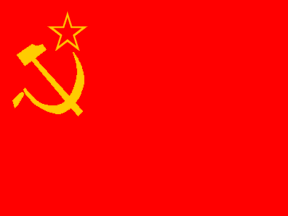
image by Marcus Schmöger, 2 August 2002
- Not very frequently red flags with yellow hammer&sickle and yellow star (USSR style) are used. See foto at <www.rifondazione.it>.
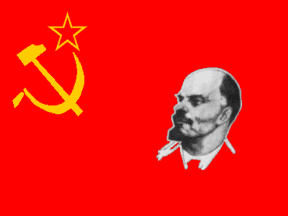
image by Marcus Schmöger, 2 August 2002
- Followers of the PdCI seem to prefer a hammer&sickle flag with the portrait of Lenin. See foto at <web.tiscali.it>.
Other flags seen during demonstrations are, for instance, the
PLO flag and the flag of the Kurdish ERNK. During one
demonstration there was also one flag of the Bloque
Nacionalista Galego. See foto at <www.rifondazione.it>.
Marcus Schmöger, 2 August 2002
.gif)
image by Marcus Schmöger, 7 August 2002
"Partito Pensionati" (Pensionaries' Party <www.partitopensionati.it>)
- This small party has been founded in 1987 as a pressure group
of the pensionaries. Otherwise the politics has been close to the
christian-democratic party/parties. Currently there is one deputy
of the party in the European Parliament.
The logo is simply the blue inscription "Pensionati" on
a white field. I haven't found a flag. Image of the logo at <cedweb.mininterno.it:8890>.
Marcus Schmöger, 7 August 2002
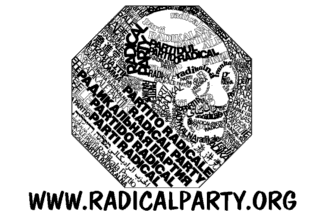
image by Marcus Schmöger, 5 August 2002
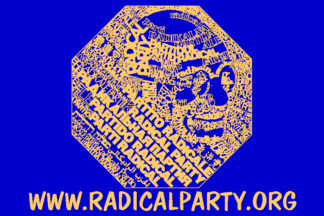
image by Marcus Schmöger, 5 August 2002
"Radicali Italiani" (Italian Radicals, a.k.a.
"Partito Radicale" or "Lista Emma Bonino" or
"Lista Pannella" <www.radicali.it>).
The "Partito Radicale" has been founded in 1955 as a
fission of the left wing of the "Partito Liberale
Italiano" (5.2.1.); one of the founders was Marco Pannella
(now leader of the party together with Emma Bonino). The party
has been and is mainly a radical-liberal and anticlerical party.
First elected to the Italian parliament in 1976 (4 deputies
including Marco Pannella and Emma Bonino), the "Partito
Radicale" could repeat small electoral successes in the
following parliamentary elections as well. At least to the world
outside Italy the "Partito Radicale" became to be
known, as porn star Ilona "Cicciolina" Staller was
elected to the parliament in 1987 on the ticket of this party.
Largely unnoticed went the election (in 1983 and 1987) of
Francesco Rutelli, later (as member of the "Verdi")
mayor of Rome, and now leader of the new centrist party
"Margherita". In elections the "Radicali"
either have presented their own lists under different names
("Lista Emma Bonino" or "Lista Pannella"
after the two most prominent figures of the party) or have (at
least) locally joined other parties for a common list (especially
the PSI and PSDI or radical-left parties as the "Democrazia
Proletaria"). This also suggests that the
"Radicali" are a more left party; therefore it was a
kind of surprise, when the "Lista Pannella" allied
itself with Berlusconi's center-right coalition for the 1996
elections. After surprisingly successful elections to the
European Parliament in 1999 (8,5% of the votes) they presented
their own list for the Italian parliamentary elections in 2001 as
well, but failed to win a seat with only 2% of the votes.
However, the main forum of the "Partito Radicale" has
never been the parliament; they focused on spectacular actions
involving hunger-strike and thirst-strike, all forms of
non-violent demonstrations and civil disobedience. The
"Partito Radicale" used with quite some success the
referendum as a political tool (for instance for the right to
divorce; against criminalization of abortion etc). Since 1985,
the "Radicali" attracted likeminded groups all over the
world and founded the "Transnational Radical Party",
that is, however, largely dominated by its Italian branch.
As symbols the "Radicali" use temporary logos for their
election lists, for instance the logo of the "Lista Marco
Pannella-Emma Bonino at <cedweb.mininterno.it:8890>.
However, the symbol of the "Transnational Radical
Party" seems to be a portrait of Mahatma Gandhi made up of
the writing "Radical Party" in many (claimed to be over
50) different languages (identification with some caution:
Italian, English, Russian, Spanish, French, Arabian, Bulgarian,
Chinese, Croatian, Dutch, Esperanto, German, Greek, Hebrew,
Hungarian, Japanese, Polish, Romanian, Turkish, and at least one
unidentified language). The portrait of Gandhi presumably
symbolizes the pacifist programmatics of the party and the use of
classical methods of civil disobedience in the political
struggle. See this logo at <www.radicalparty.org>.
This logo is also used on flags, either black on white or gold on
blue. On the flags the URL of the website
"WWW.RADICALPARTY.ORG" is written beneath the portrait
of Gandhi.
See fotos of the flag at <web.tiscali.it/falundafa/D'Amico.jpg>,
<A.Biondi.jpg>
and other places in this site as well at <www.radicalparty.org/cecenia/roma/MVC-328X.jpg>,
<MVC-333X.jpg>,
<MVC-337X.jpg>
<MVC-340X.jpg>
and many other photos in this site.
Marcus Schmöger, 7 August 2002
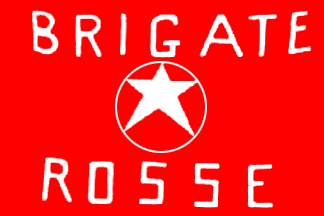
image by Anto'nio Martins-Tuva'lkin, 19 June 2004
based on <www.tkb.org>
A chronology chart at <www.brigaterosse.org>.
Insight on the group from <www.tkb.org>:
"Red Brigades
Mothertongue Name: Brigate Rosse (BR).
Aliases: Armed Communist Combatants, Italian Red Brigade, Red
Regiments.
Base of Operation: Italy.
Founding Philosophy: The Red Brigades were founded on rigidly
Marxist-Leninist principles. This radical leftist group advocated
violence in the pursuit of class warfare. Concentrated in Italy,
the Red Brigades targeted businessmen and politicians and were a
notable terrorist threat in Italy during the 1970s and early
1980s. Due to developments during its existence, the Red Brigades
took on some qualities of anarchist groups while still
propagating its especially virulent and violent Communist
philosophy. In the end, the Red Brigades' increasingly brutal
attacks eroded the support of those sympathetic with the group's
Communist ideals.
Current Goals: In April 1984, four of the Red Brigades' key
leaders wrote a communique from their jail cells. In the open
letter, the leaders proclaimed further armed combat as futile.
The Red Brigades essentially ceased to exist with this letter. In
their words, "The international conditions that made this
struggle possible no longer exist." (Xavier Raufer,
"The Red Brigades: Farewell to Arms," Studies in
Conflict and Terrorism, 1993, Vol.16)
However, the legacy of the Red Brigades continues to this day.
Following the release of this letter, two splinter groups broke
off from the Red Brigades: the New Red Brigades/Communist
Combatant Party (BR/PCC) and the Red Brigades/Union of Combatant
Communists (BR/UCC). The BR/PCC specifically has chosen to
continue in the ideological and violent path of the Red Brigades.
Further information on <en.wikipedia.org>
and <www.brigaterosse.org>.
Esteban Rivera, 8 May 2005
I'm not sure if it really was a flag proper. As with many
terrorist organizations BR used clothes or placards with their
logo as a background for photos or videos. I record seeing the BR
logo cloth especially from the famous photo of DC leader (and
former Italian prime minister) Aldo Moro, kidnapped and finally
murdered by BR, see <it.wikipedia.org>
and <projects.brg-schoren.ac.at>.
In this photo the BR cloth does not look like a flag, rather like
a hanging cloth.
Marcus Schmöger, 10 July 2005
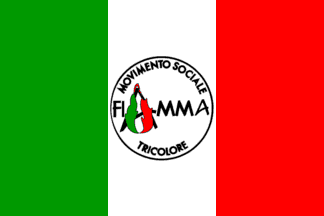
image by Marcus Schmöger, 10 August 2002
.gif)
image by Marcus Schmöger, 10 August 2002
MSFT ("Movimento Sociale Fiamma Tricolore"= Social
Movement Tricolour Flame <www.msifiammatric.it>)
- When the old MSI transformed itself into the AN in 1994/95, the
more radical wing of the party split off and founded the MSFT in
January 1995. The leader of the MSFT is Pino Rauti, former MSI
leader (1989-1991). In contrast to the AN, the MSFT adheres to a
nostalgic fascism, especially in the form of the "Republica
Sociale Italiano" di Saló (1943-45). Several groups left
the MSFT founding their own small parties, as they disliked the
dictatorial leadership of Rauti. In the 2001 elections the MSFT
only got 0,4% and 1,0% of the votes (Camera and Senato,
respectively); only one senator was elected, however on a list of
the "Casa delle libertà".
The MSFT wanted to use the old symbol of the MSI, the tricoloured
flame, but there was (or still is?) some legal quarrel with the
AN about that. So currently the MSFT uses two modified variants
of the "fiamma". The one shows a simplified tricoloured
flame together with the inscription "FIAMMA TRICOLORE".
The other one shows the flame as part of the first "A"
in the inscription "FIAMMA", together with the
inscriptions "MOVIMENTO SOCIALE" and
"TRICOLORE". The statute at <www.msifiammatric.it/statuto1_10.htm>
describes the second symbol (Art. 2):
"L'emblema del MSFT è momentaneamente costituito della
scritta Fiamma nella quale la prima A è coniugata ad una lingua
di fuoco verde, bianca e rossa sormontata dalla dicitura
Movimento Sociale e con al disotto la dicitura Tricolore il tutto
iscritto in un cerchio, fino a quando non sarà definita la
vertenza giudiziaria con Alleanza Nazionale. In caso di sentenza
positiva per il Movimento Sociale il simbolo tornerà ad essere
"una Fiamma Tricolore (verde, bianca e rossa) su base
trapezoidale contenente la sigla MSI in giallo-oro su fondo
rosso." (The emblem of the MSFT consists at the moment of
the inscription Fiamma, in which the first A is linked with a
tongue of fire in green, white and red, surmounted by the
inscription Movimento Sociale and beneath the inscription
Tricolore, the whole inscribed in a circle, as long as the
lawsuit with the Alleanza Nazionale has not been settled. In case
of a decision positive for the Movimento Sociale the symbol will
again be "a tricolored flame (green, white and red) on a
trapezoid base containing the abbreviation MSI in golden-yellow
on a red field.)
Logo at <cedweb.mininterno.it:8890>,
<www.msicivitavecchia.it/logo_fiamma.gif>
and <www.comune.cosenza.it/cs/elettorale/Image21.gif>
The second symbol is also used on flags, i.e. in the center,
white stripe of the Tricolore. Followers of the party also use
variants of the Celtic cross flags, either with white cross on
black or with black cross on a white disk on a red field.
The flags can be seen at the foto on the homepage <http://www.msifiammatric.it>.
Marcus Schmöger, 10 August 2002

image from <www.legasud.it>
, located by Dov Gutterman, 22 January 2002
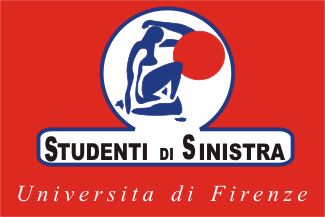
image by Jaume Ollé, 27 March 2005
.gif)
image by Marcus Schmöger, 20 July 2002
For the 2001 elections the Greens (Verdi) and one of the
socialist parties (SDI) formed a sub-coalition of the L'Ulivo
coalition, the Girasole (Sunflower). The logo combines the main
features of the logos of the two parties. They very probably
never used a flag, as this was only a quite loose coalition.
Marcus Schmöger, 20 July 2002
"Girasole" (Sunflower) sub-coalition <www.ilgirasole.org> -
Only for the 2001 parliamentary elections the Verdi and the SDI
founded the "Girasole" (Sunflower), a sub-coalition of
the Ulivo coalition. In the two parliamentary chambers the two
parties do not belong to a common group. The election emblem also
showed this temporary cooperation, as it merely combined the
smiling sun of the Verdi and the rose of the SDI. The logo can be
found at <cedweb.mininterno.it:8890>.
Obviously the Girasole has/had no flag.
Marcus Schmöger, 31 July 2002
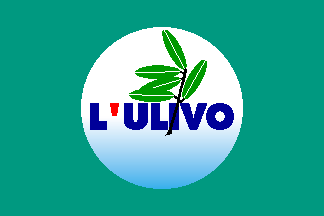
image by Marcus Schmöger, 29 June 2002
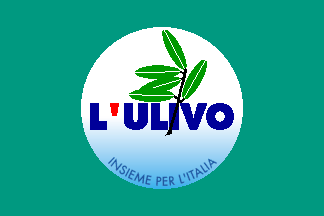
image by Marcus Schmöger, 19 July 2002
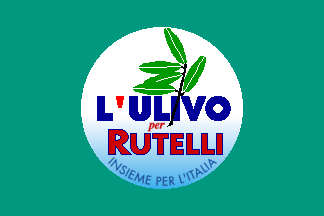
image by Marcus Schmöger, 19 July 2002
At the 1st May demonstrations in Munich there are also always
political parties and groups from foreign countries including
Italy.
Flag of "L'Ulivo" (The Olive Tree) - Several left and
centrist parties joined together in the L'Ulivo coalition for the
elections in 1996 and 2001. L'Ulivo won the 1996 election (prime
ministers were Romano Prodi und Massimo d'Alema), but was
defeated in 2001 by the right-centre coalition "Casa delle
Libertá" (House of the Liberties), led by current prime
minister Silvio Berlusconi. The parties and coalitions currently
belonging to L'Ulivo are: DS (Democratici di Sinistra);
Margherita (coalition of: PPI (Partito Populare Italiano),
Democratici, Rinnovamento Italiano, UDEUR (Unione Democratici per
l'Europa)); Verdi; SDI (Socialisti Democratici Italiani); PdCI
(Partito dei Comunisti Italiani).
The symbol of L'Ulivo is a circle of white blending into light
blue at the bottom, in the centre the inscription
"L'ULIVO" in blue (the apostrophe red), and a green
olive twig. The flag is a blueish green with the symbol in the
center.
Sources:
- own observations at the 1st May 2001 and 2002 demos in Munich
- website of L'Ulivo at <www.ulivo.it>
Marcus Schmöger, 29 June 2002
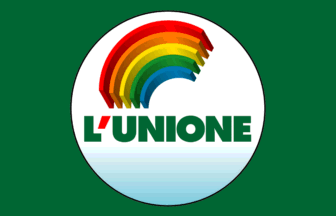
image by Marcus Schmöger, 4 December 2005
I wish to report a new Italian political flag that first came
into use in early October 2005. L'Unione (= The Union) is the
name of the new center-left wing coalition, which includes Left Democrats, Communist Refoundation Party, Italian Communists Party, The Daisy,
Socialists and Union of Democrats for Europe.
On October 9, a national rally took place here in Rome, to
promote the primary elections for choosing the coalition's
leader, held one week later. In my own experience, this was the
first time that flags bearing the logo of the new coalition were
seen. The flag measures 145 x 90 cm. Its colour is deep green,
with the round logo placed in central position; the latter
features the name of the coalition and a rainbow, on a white
background that fades into pale blue in the lower half. The flag
is printed on both sides (the logo and the lettering on the back
are reversed).
Andrea Pollett, 27 October 2005
The logo of the Unione was already shown earlier this year by
the leader of this coalition, see <www.corriere.it>.
The flags, however, have come into use pretty recently, although
somewheat earlier than suggested by Andrea Pollet. The first
documented use of this flag is from the National Festival of
Unity (Festa dell' Unità) at Milan 25 Aug- 19 Sep 2005. Photos
of the use there can be found in the Italian news magazine
L'Espresso (8 Sep 2005, p. 60; 29 Sep 2005, p. 67). There are
also photos from the web that show the flag of L'Unione, see <www.festaunita.it>.
The flag can be bought in the shop of the Left Democrats (DS),
see <www.dsonline.it>.
Marcus Schmöger, 4 December 2005
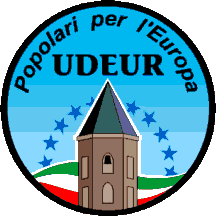
image by Marcus Schmöger, 15 July 2002
2.gif)
image by Marcus Schmöger, 15 July 2002
Two logos of UDEUR (Unione Democratici per l'Europa) . It
belongs to the left-center The Olive Tree
(L'Ulivo) coalition (currently in opposition). All these parties
belong to the sub-coalition "Margherita".
Marcus Schmöger, 15 July 2002
UDEUR ("Unione Democratici per l'Europa" = Union
Democrats for Europe <www.udeur.org>)
- The UDEUR is another small centrist, basically
christian-democratic party. Founded in 1998 by several deputies
formerly belonging to the center-right coalition, it supported
the L'Ulivo government, and became part of the L'Ulivo coalition
(Margherita sub-coalition) for the 2001 elections. The leader is
Clemente Mastella. The seven deputies in the Camera dei Deputati
were part of the Margherita group, but formed an own group in the
mixed parliamentary group in July 2002; basically the same
happened in the Senato, where five senators now form an UDEUR
group in the mixed group.
The logo of the UDEUR comes in (at least) two variants: they show
on a blue field a brown steeple, behind the steeple a wave in the
national colors; at the top the inscriptions "UDEUR"
and either "Popolari per l'Europa" or "Unione
Democratici per l'Europa"; as a symbol of its affiliation to
Europe either a circle of stars or the symbol of the European
People's Party (a letter "E" in a circle of stars).
Logos at: <digilander.iol.it/udeur>
and <www.udeur.org>.
I don't know if the UDEUR has a flag.
Marcus Schmöger, 1 August 2002
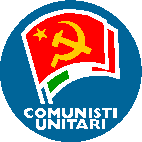
image by Marcus Schmöger, 2 August 2002
A left-wing federation
G. Vacca, 22 September 1997
Two groups split off from the RC (Communist
Refoundation Party - Partito della Rifondazione Comunista)
consecutively. The first (in 1995) were the "Comunisti
Unitari" (Unitarian Communists), that joined DS (Democrats of the Left) in 1998. The
logo of the "COMUNISTI UNITARI" was a blue circle with
the name of the party (in white) under the red flag (with yellow
star, hammer & sickle) partially covering the national flag.
As the "Comunisti Unitari" were a short-lived party not
very active in public, I'm not sure if they had a flag.
Marcus Schmöger, 2 August 2002
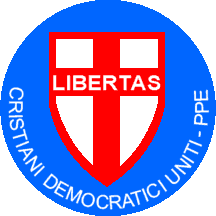
image by Marcus Schmöger, 15 July 2002
Logo of CDU - Cristiani Democratici Uniti. No flag found. CDU
belongs to the right-center coalition House
of the Liberties (Casa delle Libert?) led by prime minister
Berlusconi.
Marcus Schmöger, 15 July 2002
CDU ("Cristiani Democratici Uniti" = United
Christian Democrats <www.cdu.it>)
- After the electoral defeat in 1994, the PPI majority wanted
cooperation with the left coalition (led by the PDS), whereas a
minority, including the party leader Rocco Buttiglione wanted to
cooperate with the right coalition of Berlusconi. Subsequently
the PPI split (involving some legal quarrels about the name etc),
and the right part became known as CDU in July 1995. The short
form has been deliberately chosen to resemble the German CDU. The
current leader is Rocco Buttiglione. For the 1996 and the 2001
elections the CDU joined the center-right coalition of Berlusconi
(together with the CCD).
I have not found any flag. The logo shows (on a blue background)
the shield of the old "Democrazia Cristiana" (white
shield, fimbriated red, a red cross and the white inscription
"LIBERTAS" on the transverse bar of the cross) and the
name of the party .The logo at <www.cdu.it/img/cmainbr.jpg>.
Marcus Schmöger, 7 August 2002